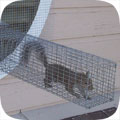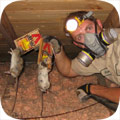- santafe@wildlifeanimalcontrol.com
Call 24/7 for a free quote:
505-404-0313
Santa Fe Wildlife Animal Control
Professional Wildlife Removal Company Servicing Santa Fe, NM
If you have a problem with wildlife in your Santa Fe home, your best option is to hire a company that specializes in New Mexico wildlife removal only. This is a specialty business, and regular pest control companies do not use the proper techniques to solve animal problems. I have spent many years reviewing New Mexico and Santa Fe, and I recommend the following:
Critter Control
Cell Phone: 505-404-0313
NOTE: If you have a dog or cat problem, call Santa Fe County Animal Services: (505) 986-2430

Critter Control specializes primarily in removing animals from attics of homes and buildings - this includes squirrels in attics, raccoons, and rats or mice in homes. New Mexico also has a documented problem with
bats in buildings, and Critter Control is specially trained in bat removal. They also perform general wildlife trapping services, such as the capture and removal of skunks or opossums on the
property. Call 505-404-0313 to discuss your critter problem and schedule a same-day or next-day appointment. Click here to learn more about what prices we charge in 2020.
When hiring a company to solve your wild animal problem, you want these features:
- Specializes in wildlife removal, not pest control
- Fully New Mexico and Santa Fe County licensed and insured
- Works 7 days per week (critters don't take weekends off)
- Performs full building inspections: enters and inspects attic
- Performs exclusion repairs, with guarantee against animal re-entry
- Offers cleanup of biohazardous wildlife waste
Critter Control is a full-service Santa Fe wildlife removal company. This is very different from a regular Santa Fe pest control company. The pest control companies spray poison to kill insects. This is not at all
similar to wildlife removal. Critter Control performs a full inspection of the home or property, and determines why the animal(s) are there, and if inside a building, how the animals got inside. All
animals (including rodents) are trapped and removed, or if possible, removed from the building using special exclusion devices. Once the animals are gone, preventative repairs are essential, and
cleanup is sometimes recommended.
 Santa Fe wildlife trapping - it's not as simple as it may seem. It's illegal in New Mexico to trap without a license. Trap type is very important and there are many different types, bait is somewhat relevant, trap placement
is vital, and there are dozens of small things that are very important to know.
Safety is a concern. Then once the animal is trapped, it must be removed and dealt with in the proper manner according to New Mexico law. We offer Santa Fe raccoon removal. Read more about how to get rid of raccoons.
Santa Fe wildlife trapping - it's not as simple as it may seem. It's illegal in New Mexico to trap without a license. Trap type is very important and there are many different types, bait is somewhat relevant, trap placement
is vital, and there are dozens of small things that are very important to know.
Safety is a concern. Then once the animal is trapped, it must be removed and dealt with in the proper manner according to New Mexico law. We offer Santa Fe raccoon removal. Read more about how to get rid of raccoons.
 Animals in attics - this is our specialty at Critter Control. Many types of animals like to live in attics. This includes squirrels, raccoons, rats, mice, bats, birds, and even possums. Critters like to go into attics for a safe place to live
and raise their young. Removing animals from attics is very complex work, partly because of the presence of baby animals. If you need Santa Fe squirrel removal, we can remove all the squirrels from your attic, and seal out any future ones. Read more about how to get rid of squirrels.
Animals in attics - this is our specialty at Critter Control. Many types of animals like to live in attics. This includes squirrels, raccoons, rats, mice, bats, birds, and even possums. Critters like to go into attics for a safe place to live
and raise their young. Removing animals from attics is very complex work, partly because of the presence of baby animals. If you need Santa Fe squirrel removal, we can remove all the squirrels from your attic, and seal out any future ones. Read more about how to get rid of squirrels.
 Rodent control must be done in a very specific way. First off, the most important thing is that all the openings that rats and mice can use to enter a house be sealed. Then all the rodents must be physically trapped and removed.
Never, ever use poison! Most Santa Fe exterminators will just use this lazy poison technique to kill rodents, and it causes more harm than good - dead stinky rats, and it doesn't solve the problem. Call us for correct Santa Fe rat removal. Read more about how to get rid of rats.
Rodent control must be done in a very specific way. First off, the most important thing is that all the openings that rats and mice can use to enter a house be sealed. Then all the rodents must be physically trapped and removed.
Never, ever use poison! Most Santa Fe exterminators will just use this lazy poison technique to kill rodents, and it causes more harm than good - dead stinky rats, and it doesn't solve the problem. Call us for correct Santa Fe rat removal. Read more about how to get rid of rats.
 Bat removal is a highly specialized task. New Mexico is known to have colonizing bats who often live in buildings. Bats love attics. If not removed, the colony can grow to a very large size over the years. The bat droppings are often corrosive and
cause health risks. The same goes for bird droppings on or in buildings. We perform Santa Fe pigeon removal and bird control. But our specialty is Santa Fe bat removal. We remove 100% of the bat colony and seal the building so that it's totally bat-proof. Read more about how to get rid of bats.
Bat removal is a highly specialized task. New Mexico is known to have colonizing bats who often live in buildings. Bats love attics. If not removed, the colony can grow to a very large size over the years. The bat droppings are often corrosive and
cause health risks. The same goes for bird droppings on or in buildings. We perform Santa Fe pigeon removal and bird control. But our specialty is Santa Fe bat removal. We remove 100% of the bat colony and seal the building so that it's totally bat-proof. Read more about how to get rid of bats.
 If you have animals inside a house, no job is complete without proper exclusion repairs. If you simply hire a Santa Fe trapper who only removes the critters, then the problem will return. You need to hire a Santa Fe wildlife control company that identifies 100% of the animal entry points
into your building, and seals them shut with professional repairs. In addition, in many cases animals have left waste or contamination behind, and you'll want a company that can provide professional cleaning services. Critter Control does both.
If you have animals inside a house, no job is complete without proper exclusion repairs. If you simply hire a Santa Fe trapper who only removes the critters, then the problem will return. You need to hire a Santa Fe wildlife control company that identifies 100% of the animal entry points
into your building, and seals them shut with professional repairs. In addition, in many cases animals have left waste or contamination behind, and you'll want a company that can provide professional cleaning services. Critter Control does both.
The above are just some of the services offered by Critter Control. We also trap and remove animals that destroy lawns, such as moles, or digging animals. Sometimes animals like opossums will live under buildings, steal pet food, raid garbage cans, etc.
Read about how to get rid of opossums. Skunks commonly live under sheds or decks, and set up a den. We can trap and remove them without them spraying. Read about how to get rid of skunks. Critter Control
also provides dead animal removal in Santa Fe. If you need help with any other wildlife conflict, from a fox, beaver, groundhog, or any other critter, we can solve it. We also do Santa Fe snake removal - most of the snakes in New Mexico are not venomous, but
call us if you want safe removal, or read about how to get rid of snakes in Santa Fe. And remember, we are a private business, not Santa Fe County Animal Control Services, so if you have a dog or cat problem, call the County at (505) 986-2430.
Santa Fe County animal services does not handle any wildlife issues.
Critter Control: 505-404-0313
Santa Fe Pricing Info For Year 2020
 Every wildlife removal situation is different, from the species of animals involved, the location of the animal inside a house or outside, the extent of repairs or cleanup, etc. It's impossible to give one-size-fits-all prices. Examples MIGHT include:
Every wildlife removal situation is different, from the species of animals involved, the location of the animal inside a house or outside, the extent of repairs or cleanup, etc. It's impossible to give one-size-fits-all prices. Examples MIGHT include:
Small Job: For example, a one-stop job to remove an animal in the yard: $100 on up
Medium Job: For example, getting critters out of your house with minor repairs: $300 on up
Large Job: For example, a project involving many service trips and complex work: $500 on up
Give us a phone call now and tell us about your wildlife issue and we will be able to give you a price estimate over the phone. If you're cool with it, we can schedule a same-day or next-day appointment if you like. Our prices are fair, and a good value because we do the job right, the first time.
Santa Fe Wildlife Tip #1:
What to do about wild critter feces in the yard - Animals don't mean to be as gross as they are, but unfortunately it just kind of happens. When an animal has to go to the toilet, they have to go to the toilet and there is not very much that you can do about it. However, if you have noticed that your family dog or cat is pooping in places that it usually wouldn't, resulting in a rather stern telling off from you, you should probably reevaluate the situation to make sure that the culprit really is who you think it is! Wild critter poop is the same size as the poop that your average medium sized house dog will leave behind, which is why it is often mistaken for dog poop. The only problem with this is that the poop left behind by the wild critter is likely to contain some rather nasty bugs that you are not going to want to put yourself in contact with, and also that you will need to clean up n the safest way possible! Gloves - this cannot be stressed enough - you are going to need some very sturdy, very strong, preferably rubber gloves. These will keep you protected. You will also need bleach to clean the materials that the poop has come into contact with, especially the gloves if you have decided that you don't want to throw them away. At the same time, you are either going to want carrier bags to contain the poop and handles to tie the garbage can lid down with after you have placed the poop in there, or a bonfire so that you can burn it and get rid of it once and for all!
Santa Fe Wildlife Tip #2:
Coon trapping tips - Knowing the right way to trap a coon is what will make or break your task. First, you need to decide how you're going to handle the trapping. If this is a nuisance animal, there is no reason to use a lethal trap. A cage trap will work well to get the animal and safely relocate it. Trapping a raccoon during trapping season requires a special license, but it also means using a lethal trap. No matter what traps you use, you need to know how to set them properly. All traps should be set on level ground where they are not likely to wobble. You never want to do anything that makes the target animal suspicious, and a wobbly tap will certainly set off alarm bells. Your next task will be to decide what bait to use. Raccoons like to eat a variety of items, but if you're trying to trap just raccoons, you should stay away from a meat product. Too many other scavengers are drawn to meat. Coons will come to a trap filled with marshmallows or bread. There is no need for anything additional.
New Mexico Wildlife Information:
New Mexico State Bird: Roadrunner
State mammal: American black bear
State reptile: New Mexico whiptail lizard
State amphibian: New Mexico spadefoot toad
State fish: Rio Grande cutthroat trout
State insect: Tarantula hawk wasp
New Mexico has very little surface water; in fact, only about 250 square miles are above-ground water in the state. Surprisingly, despite this limited amount of H20, there is an abundant amount of wildlife in the region. This is mostly attributed to the wide variety in landscape. The state has a portion of the Great Plains, which is very similar to the grassy lands in part of Colorado. In addition to the plains, there are semi-arid regions with cacti and short brush, and areas with coniferous forests hidden in the mountains. What peaks aren't mesas and sandstone formations are often snow-capped and found in the portion of the Rocky Mountains that sneaks through New Mexico. Like most desert regions, the state's arid zones are extremely hot during the day and become extremely cold at night.
The two extremes in temperatures allows for the region to keep animals that would traditionally dislike the heat content. Larger animals, like the coyote, can sleep in shaded dens during the heat of the day, emerging at night to hunt. There are many animals, even the smaller rodents, which prefer this sort of schedule. Snakes and other reptiles are the most common animals seen out in the bright sunlight. These animals, including a common snake-the rattlesnake-are often seen basking on rocks.
Small animals aren't the only ones in the state, though there are a fair number of common pest creatures like raccoons, porcupines, skunks, rats, mice, rabbits, and foxes. Large animals, those that often like to live in the higher elevations, are creatures like elk, pronghorns, white-tailed deer, black bears, mountain lions, and Mexican grey wolves.
New Mexico is home to many endangered species as well. The state's species are relatively well protected because of how many live in unpopulated areas. Most are birds like the bald eagle and the whooping crane, though many are also fish. The loss of fish species is not surprising considering how scarce water is in the region. During drier seasons, fish are forced to live in closer proximity to one another. Some species prey on others, making the decline of fish dependent on the weather. The less water is available, the less prey is also available on land, and some terrestrial species have been known to turn to fishing when food is scarce.
You can always call Critter Control, any time of day, at 505-404-0313, for a price quote for Santa Fe wildlife control services. I am confident that this is the best choice amongst wildlife removal companies in Santa Fe, NM.





































